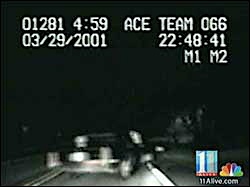High-speed chase — repercussions — reaches Supreme Court
The police cruiser rammed the black Cadillac from
behind as they raced along a wet, two-lane road near Atlanta at roughly 90 miles
an hour. The Cadillac’s 19-year-old driver lost control and ended up at
the bottom of an embankment, paralyzed.

The police cruiser rammed the black Cadillac from behind as they raced along a wet, two-lane road near Atlanta at roughly 90 miles an hour. The Cadillac’s 19-year-old driver lost control and ended up at the bottom of an embankment, paralyzed.
Victor Harris was being chased by police because he had been speeding. He said later he was too frightened to stop. Coweta County sheriff’s deputy Timothy Scott said he wanted to end the chase before other drivers or pedestrians were hurt.
Harris sued Scott for violating his civil rights and the case has reached the Supreme Court, where it will be argued on Monday. The deputy wants the justices to conclude that his actions, captured on the dashboard camera of his car, were reasonable and dismiss the lawsuit.
It…is the first case in more than 20 years in which the court will consider constitutional limits on police use of deadly force to stop fleeing suspects. Courts define deadly force as creating a substantial risk of death or serious injury.
Well — should there be an ironclad rule governing all such chases? Or do we allow individual police officers decide how to proceed within their view of that moment of conflict between law-breaker and law-enforcement?
Posted: Mon - February 26, 2007 at 06:10 AM